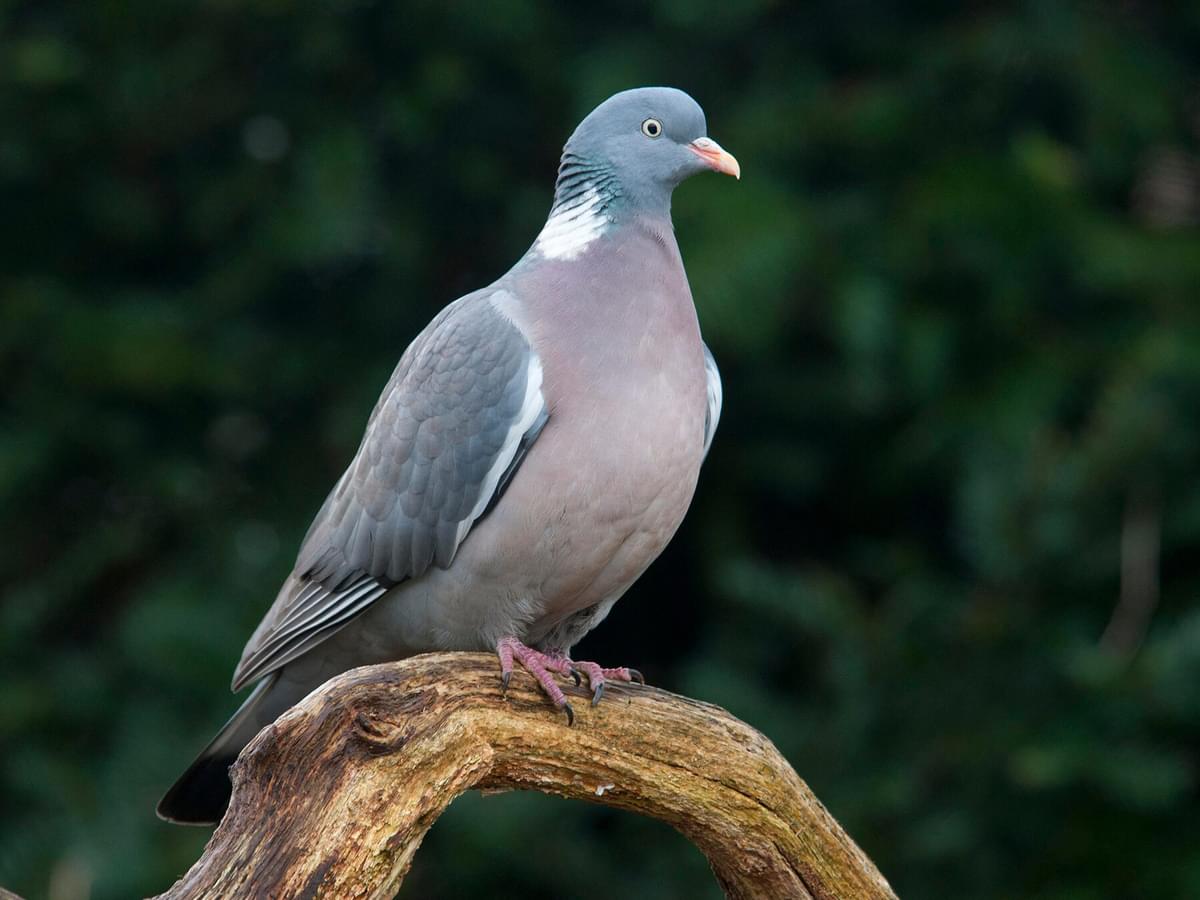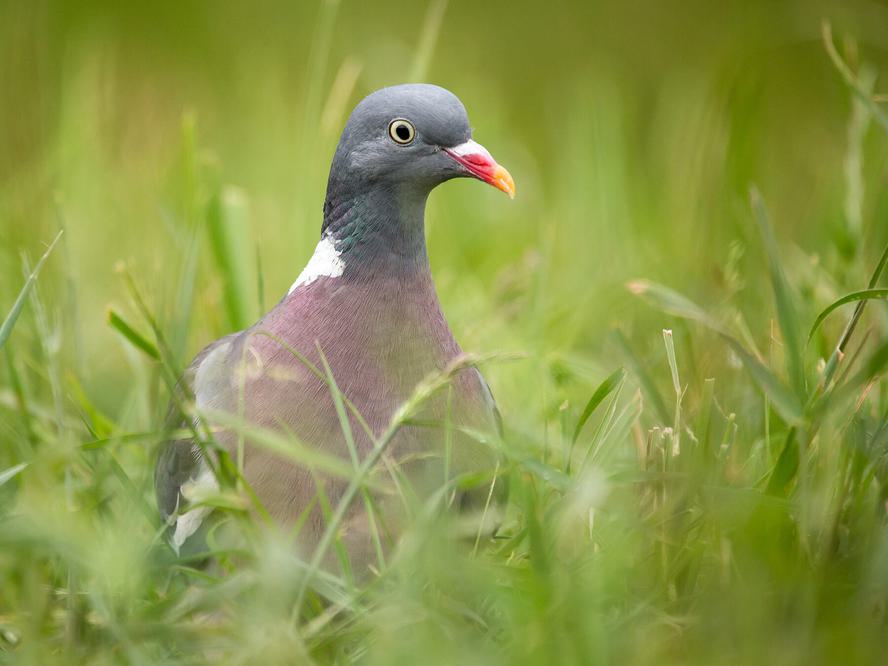Jump to Section
Wood Pigeon Nesting (All You Need To Know)
Last updated: 2 February 2023

Wood pigeons are common throughout the UK and Central and Western Europe. These highly intelligent birds are not to be confused with feral pigeons - they’re their own species Columba palumbus, from the large Columbidae family of pigeons and doves. As one of the UK’s most common garden birds, many people will 'likely have seen a Wood pigeon nest.
Wood pigeons prefer to nest in trees, hedgerows and other dense natural foliage, but they’re flexible and will choose buildings and ledges if they can access them. Their nests are not impressive - they’re small, loose constructions that take just a week or so to build. However, you can’t say that Wood pigeon nests don’t do the job, as many pairs successfully raise more than one brood a year.
Of course, there is more to learn than that! Read on to learn everything there is to know about Wood pigeon nesting habits.
| Key Wood Pigeon Nesting Facts | |
|---|---|
| Nesting season | Mainly from late February to early September |
| Nesting material | Sticks |
| Nest type | Rough circle of stacked sticks |
| Nest location | Woodland trees and hedges, but will nest in gardens |
| Number of broods | One to two broods |
| Clutch size | 2 eggs, but range from 1 - 3 |
| Egg colour | Smooth and glossy white |
| Egg size | 41 x 29 mm |
| Egg weight | 18.9 g |
| Incubation period | 16 - 17 days, by both male and female |
| Fledgling period | 28 - 29 days after hatching |
| Reuse nests | Often |
| Use nest boxes | No |

The nest of a Wood Pigeon with two eggs inside. The nest is tucked away in a hawthorn hedge.
Where do Wood pigeons nest?
Wood pigeons typically nest in woodland trees and hedges. Trees are by far their preferred nesting sites, especially large deciduous trees in ancient woodland.
Their name isn’t misleading - Wood pigeons do genuinely love woodland habitats, but some 50% of Londoners are now spotting them in their gardens, which means they’re no stranger to urban nesting.
While widespread throughout the UK and much of Europe, you’re more likely to see Wood pigeons in semi-rural or rural environments. Though flexible with their nest, Wood pigeons prefer to build their nests in trees at the height of around 5m minimum. Most nests are built close to a large tree’s trunk and major branches, typically in the mid-storey of a deciduous tree.

A wood pigeon sat on the nest in a tree
What do Wood pigeon nests look like?
Wood pigeon nests are unelaborate and straightforward. They’re platforms of similarly-sized twigs stacked in a rough circle.
Measuring around 20 to 30cm wide, pigeon nests are just as big as they need to be. In towns and cities, Wood pigeon nests often look very quick and sloppy, similar to feral pigeons.
Sometimes, Wood pigeons will nest in the unused or abandoned nests of other birds. Despite looking precarious and thin, many Wood pigeon nests do survive all year and are reused or upgraded the next year. This is especially true if the couple raises a successful brood in that nest or nest site.

Female Wood Pigeon in the nest with her recently hatched chick
What time of year do Wood pigeons nest?
Wood pigeons are prolific breeding and have been recorded nesting and breeding in every month of the year.
This is uncommon behaviour - most birds stick to the traditional spring breeding season, which runs from March until August latest. On the other hand, Wood pigeons may attempt their first brood in February and continue throughout most of the spring, summer and winter. Their peak breeding season is still between March and July, but late broods in November and December are not unheard of.
The Wood pigeon’s flexible breeding habits are partly why it’s successful, and it maximises their chance of raising at least one successful brood every year.

Close up of a Common Wood Pigeon sat on the nest
How long do Wood pigeons nest for?
The Wood pigeon breeding season is a long one, and many pairs will nest from around March until October, November or even December. If Wood pigeon couples fail to raise a successful brood, they’ll try again some six times in one year!
Wood pigeon nests are sometimes ‘topped up’ at funny times of year in preparation for a brood, but they’re more likely to nest in the traditional spring breeding season, which peaks from March to July. Once established, Wood pigeons will return to the same nest year-on-year if possible.
How do Wood pigeons build their nests?
Wood pigeons work together to build their nests, though the male often transports material to the nest as the female assembles it. Once accumulated, the male and female will work together to fashion the nest into a stable platform.
If you have Wood pigeons nesting nearby, you might be able to spot some of their trips back and forth from the nest with twigs in their mouths. During the breeding season, Wood pigeons will work throughout much of the morning, day and afternoon to establish and maintain their nest.

Wood Pigeon gathering nesting materials
When do baby Wood pigeons leave the nest?
Baby Wood pigeons (also sometimes called squabs) fledge and leave the nest after around 30 to 36 days, possibly sooner in summer.
They may leave the nest a few days before and shuffle their way to a treetop perch. Baby pigeons will make their first flight sometime after 30 days, but will likely remain close to their parents for a few weeks after. Once fledged, Wood pigeons grow quickly and reach sexual maturity after around 7 months to a year.
How many broods do Wood pigeons have?
Wood pigeons usually have one or two, broods per year, but if their initial broods fail, they’ll attempt up to six.
It all depends on whether the couple successfully raises their chicks - Wood pigeons only have two chicks, so they'll try to raise more than one brood to compensate.
Generally speaking, Wood pigeons will attempt to breed for as long as conditions allow. In the UK, there is evidence that the Wood pigeon breeding season has increased due to the high availability of crops in late summer and early winter.

Wood Pigeon with two squabs (chicks) in the nest
Do Wood pigeons nest in the same place every year?
Wood pigeons in the UK and Ireland tend to be residents, meaning that they don’t migrate. They often return to the same nest if it survives from brood to brood, or will build a new nest close to the old one.
Many Wood pigeons won’t stray too far from where they’re born, and many juveniles return to their natal habitat to breed themselves.
So, if you have Wood pigeons in your garden during the spring, you might notice that they return every year. Migrating Wood pigeons from other parts of Europe will also return to the same breeding sites each year.
What do Wood pigeon eggs look like?
Wood pigeon eggs are a very smooth and glossy white. They measure around 30mm x 41mm on average.

Two wood pigeon eggs
What month do Wood pigeons lay eggs?
Wood pigeons have been recorded breeding in every month of the year, but their peak months are still in the spring breeding season, which runs from March to July.
However, Wood pigeons often push on a little into winter, and late broods in December aren’t unheard of.
Do Wood pigeons use nest boxes?
Wood pigeons are not known to use nest boxes. They’re too large and prefer natural, dense vegetation if possible.

A breeding pair of wood pigeons
Where do Wood pigeons nest at night?
In the breeding season, Wood pigeons will roost in their mated pairs - they’re not gregarious while nesting and raising young. They’ll probably sleep in trees and bushes at night.
In the winter and outside the breeding season, Wood pigeons are often very gregarious and form large flocks for feeding and roosting.
Do Wood pigeons nest in gardens?
Wood pigeons will certainly nest in gardens if they contain a valid habitat, like a tall, densely-foliaged tree.
While Wood pigeons are common in the UK, they were recently placed on the Amber List as a ‘Bird of Concern’ - we must work to support this native bird as we do with others.
Wood pigeons are unfussy with regard to food and will gorge themselves on standard bird seeds. You can also place small bundles of sticks out in the breeding season to see if any Wood pigeons choose to take any materials for their nests nearby.
On this page
- Where do Wood pigeons nest?
- What do Wood pigeon nests look like?
- What time of year do Wood pigeons nest?
- How long do Wood pigeons nest for?
- How do Wood pigeons build their nests?
- When do baby Wood pigeons leave the nest?
- How many broods do Wood pigeons have?
- Do Wood pigeons nest in the same place every year?
- What do Wood pigeon eggs look like?
- What month do Wood pigeons lay eggs?
- Do Wood pigeons use nest boxes?
- Where do Wood pigeons nest at night?
- Do Wood pigeons nest in gardens?






